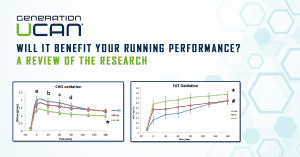Recently there has been renewed interest in a dietary strategy that actually limits the athlete’s access to carbohydrate during training in order to enhance the body’s adaptations to training and fuel utilization.
The “train low” theory (training with low carbohydrate availability) stemmed from the discovery that the transcription of a number of genes involved in muscular adaptations to training is enhanced when exercising with low muscle glycogen. Of particular interest is the body’s increased ability to use fat as fuel and thus rely less on glycogen.
The flip side of training low is competing “high”, or with full glycogen stores and carbohydrate availability, in order to promote optimal performance.
Training with low carbohydrate seems counterintuitive since it is well documented in the scientific literature that the availability of carbohydrate during intense, prolonged endurance exercise is a major determinant of overall performance. However, if occasional training with low glycogen stores can allow you to optimize your utilization of fat as a fuel, you may be able to better preserve your glycogen stores for later in the race.
The key question for researchers is whether or not training low and competing high truly offers performance benefits beyond having high carbohydrate availability throughout both training and competition.
How is low-carbohydrate availability achieved?
There are a number of ways to limit carbohydrate availability during training, either through dietary manipulations or training schedules.
- From a dietary perspective, low glycogen could be achieved by consuming a diet chronically low in carbohydrate, withholding carbohydrate intake during prolonged training sessions (i.e. long runs), or delaying carbohydrate intake for the first few hours after a hard workout.
- From a training perspective, there are two approaches that have been more commonly used in research studies and real life practice. One approach is to train early in the morning before having your first meal (in a fasted state). The other is to complete a morning workout in the fueled state, withhold carbohydrate during recovery (similar to the third dietary strategy above), and then complete a second workout later that same day with depleted glycogen.
What does the research show?
Researchers have been able to identify muscle markers that indicate adaptations to training are enhanced when exercise if performed with low muscle glycogen. Furthermore, they have shown that training in a fasted state promotes different training adaptations compared to those seen when carbohydrate is taken before and during training.
However, it is unclear whether or not these enhanced training adaptations translate into real performance benefits.
A key highlight in these research findings is that although training with low glycogen during a hard workout results in enhanced muscle adaptations, these athletes had a lower power output during that workout compared to athletes with high carbohydrate availability. In other words, they weren’t able to do as much work when carbohydrate wasn’t available.
So do the enhanced training adaptations make up for a decrease in total work done?
When the athletes in these studies were asked to do a performance test ride at the end of three weeks of training according to either the “low” or “high” protocols, both groups showed equal improvements in performance.
So, what does the research tell us?
A review study by Burke examined how research has shaped carbohydrate recommendations over time, as well as the few emerging studies that test the hypothesis that training “low” and competing “high” will result in greater performance.
While most all research concludes that the availability of carbohydrate during intense, prolonged endurance exercise is a key determinant of success, there is no clear evidence from the studies reviewed to support a performance advantage from adhering to a “train low” strategy.
Burke offers a number reasons for why researchers have failed to see a performance benefit despite the enhancements in training adaptations.
- Study periods are too short
- Lack of a true connection between performance and the muscle markers measured
- Possible negative outcomes resulting from training low that were not measured
- Inadequate measures of performance that translate to real life scenarios
After Burke published this review, Stellingwerff decided to address that last issue by taking laboratory data and putting it into practice in real life.
He tracked three elite Canadian marathoners during a 16-week training protocol leading into a major marathon. Among other training and dietary approaches, each athlete included low carbohydrate training sessions into their marathon cycles.
Stellignwerff suggests that highly trained athletes may need to periodically incorporate low-carbohydrate training sessions in order to get the full effect of endurance training adaptations.
How did these elite marathoners structure there “train low” strategy?
- The majority of these low-carbohydrate training sessions consisted of morning runs done in the fasted state (just water or coffee beforehand).
- Only about 10% of the low-carbohydrate sessions we done with reduced glycogen stores (a second training session following a hard interval session with no glycogen replacement over 4+ hours).
- Low carbohydrate training sessions were done an average of 2.5 times per week during the general and specific preparation phases and less than 1.5 times per week during the 3-week race taper.
The results? Two of the marathoners in this study set PRs of 2:11:23 and 2:12:39 and the third marathoner had a debut of 2:16:17. Although these performance enhancements cannot be linked directly to low-carbohydrate training, Stellingwerff was able to show that low-carbohydrate training could be successfully integrated into real life training and competition.
Things to keep in mind
In her review, Burke concluded that there is “insufficient evidence to provide guidelines to athletes for incorporating ‘train low’ strategies into their training programs.” However she also suggests that many athletes may already be doing this without knowing.
For example, many athletes do early morning training runs without eating first. Some athletes do 2 or more workouts per day without sufficiently replenishing their glycogen. And finally some athletes do long training runs (>90 minutes) without taking in any carbohydrate at all.
My suggestion is to tune into your training and assess if you are currently doing any of your training with low carbohydrate. If you are and everything is feeling good, it is probably okay to continue that.
If you do want to specifically include glycogen depleted runs, here are my suggestions:
- You should run your early training segment long runs in a glycogen depleted state.
This will teach your body to boost glycogen stores and increase fat as a fuel source early in the training cycle. However, because the long runs won’t be too long, you don’t run a high risk of bonking and sacrificing a critical 20 or 22 mile long run.
- Run your last 3 quality long runs in a glycogen loaded state.
In doing so, you will increase the overall quality of these important long runs, enabling you to finish faster, and recover more quickly. Likewise, you can practice your marathon nutrition strategy to acclimatize your stomach to processing simple sugars and fluids efficiently.
- And finally, it should be noted that low carbohydrate training does not mean the same thing as a low carbohydrate diet. All of the athletes in these studies still maintained a high carbohydrate diet according to their needs, they just consumed the carbohydrate at different times depending on the type of training session.
By implementing both glycogen depleted and glycogen loaded long runs, you can improve the critical fuel efficiency element of the marathon while maintaining consistency in your training.
References
2. Baar K, McGee SL. Optimizing training adaptations by manipulating glycogen. Eur J Sport Sci, 2008; 8:97-106.
Hawley JA, Tipton KD, Millard-Stafford ML. Promoting training adaptations through nutritional interventions. J Sports Sci, 2006; 24:709-721.
3. Stellingwerff T. Case study: nutrition and training periodization in three elite marathon runners. International Journal of Sports Nutrition and Exercise Metabolism, 2012; 22:392-400.





One Response
Hi Jeff, thanks for another great article. I am in the early phase of my marathon training cycle, and would like to try out a few glycogen depleted long runs. For how many weeks of the 16 week cycle would you recommend this? Is there any merit in doing Easy runs other than long runs in a glycogen depleted state?